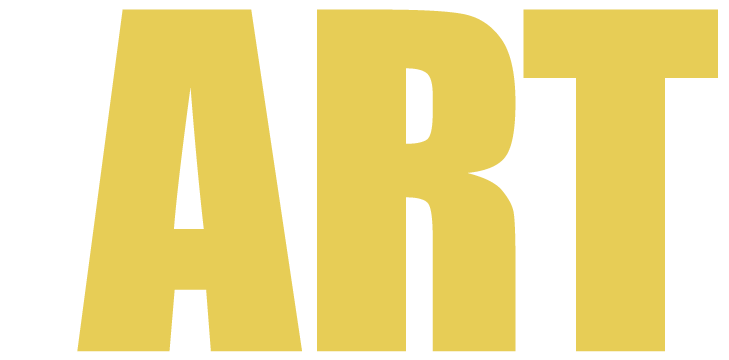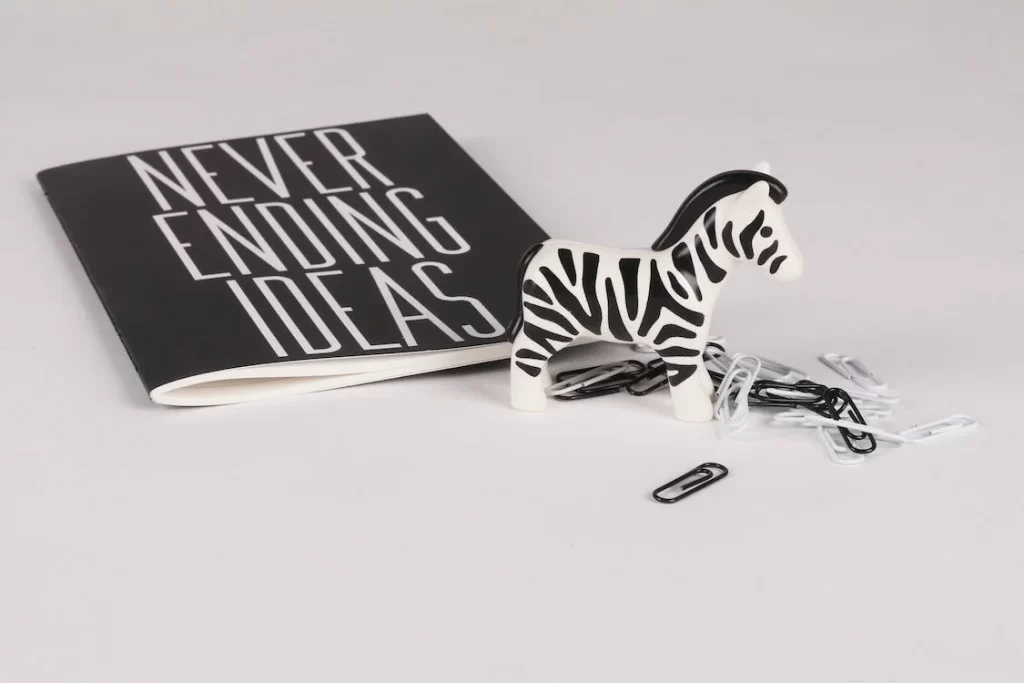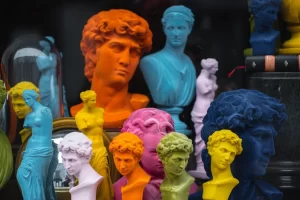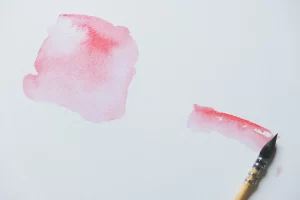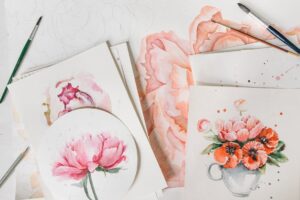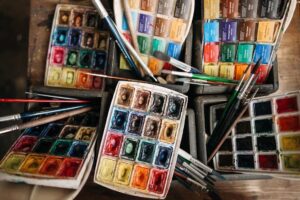Most people believe that to be creative, one must be born that way, with a special talent. They also tend to believe that to be creative is to be able to make things. Creativity isn’t just the ability to create art; it’s a way of thinking, a manner of perceiving the world, and a means of expressing unique perspectives. It’s about seeing connections where others might see gaps and imagining what could be, rather than just what is. In this article, you will learn a few methods on how to be creative.
Intro to How Creativity works
The process of convergence is when things come together. Its complement, divergence, is when things branch out. Psychologist, J. P. Guilford, coined the terms “Divergent and Convergent Thinking”. When we solve problems, convergent thinking is responsible for narrowing down one’s options until we find The solution that works best. This works very well when solving logic based problems, or problems under stress, but not so much when solving problems that require new ideas to emerge.
That’s where “divergent thinking” comes in. While convergent thinking closes us off from unwanted information, divergent thinking opens us up to further ideas. When using both together, we get creativity. We are seeking out new ideas, and then scrapping the ones that don’t work, over and over again in rapid succession. That’s creativity in a nutshell.
The Moods Effect On Creativity
First things first- Stress plays a huge role in whether or not you’re creative. Consider you had a burst of inspiration one day and wrote a poem, made up a joke, drew a picture, etc. The feeling while creating is usually high energy, which opens the mind to many ideas, but with no specific end goal. There is no feeling of anxiety or stress because there is no point of failure. This happens to many people randomly from time to time. The goal is to reverse engineer this phenomenon and get it to happen on purpose.
When we are stressed, grumpy, sad, low energy, our brains focus more on limiting energy usage. Part of the way it does that is to close itself off and limit the things you can think of, or think of doing. Your perceived possibilities shrink when you don’t feel like you have enough resources to explore. So first get some rest, and then find a small block of time when you aren’t bothered by distractions if you want your mind limber for creativity.
Children and Adults. How They Differ in Terms of Creativity.
Rules are limitations. They help structure the world around us and they typically boil down to – This can be or that can’t be. Sometimes with an explanation, sometimes without.
The main difference between a child and an adult is that the child doesn’t know many rules, and is taught. When the child has been taught, has internalized, and adheres to enough rules to fully care for itself, we call it an adult. At this point, creativity has mostly been replaced by the recipes for life. While creativity built the world around us, learning to adhere to this world’s rules is the opposite of creativity.
To your typical adult, a pigeon can’t lift a horse. It would be absurd. We know the rules. To a kid, who doesn’t know any rules, first a pigeon can lift and carry a horse, and we’ll figure out why it’s true if and when anybody asks. There is little doubt or uncertainty in a child’s mind. Doubt and uncertainty are taught, and for good reason; but they do not help our cause of creativity.
When we suspend the disbelief perpetuated by all the rules we are made aware of, we open up our minds to finding new connections, making new discoveries. When coupled with adult benefits, like our enhanced capacity for logic and problem solving, we can make creativity formulaic – Come up with an idea, figure out the logistics later. We remove the rules to find something new, then we reapply just enough rules to make it work.
Tips and Exercises to Release Creativity and Explain How To Be Creative
Meditation
There’s a commonly known type of meditation called Mindfulness Meditation. The purpose is to practice being mindful, which has many cognitive and physical health benefits. It’s easy to try. Pick one single thing to focus on, like a word, a crack in your ceiling, some bauble, Anything. Try to focus on just that thing you picked for about 10 minutes. You’ll likely notice your mind getting tired before then. You will also notice that other thoughts always pop into your head, outside noises will distract you. But if you do it enough times, you will get better at it. What this does is strengthen the mind’s ability to ignore interference, and narrow our focus to a single point. Convergence.
But what many people don’t know is that there are two kinds of mindfulness meditation. The aforementioned is known as “Single Point Meditation”. The other kind is called “Open Awareness” meditation, which strengthens Divergent thinking. Use one before you need to focus hard on something, use the other before you need to be creative.
In Open Awareness, instead of choosing one thing to focus on, you focus on everything all at once. Every inch of your body, and everything happening around you for about 10 minutes. You will notice the opposite happens from single point meditation, when distractions came from everywhere. This time you will find yourself paying too much attention to one thing when you’re trying to be distracted by everything. Again your mind will get tired but practice over time is the key.
Using these meditation techniques as needed, you are essentially tuning your mind and body for the task at hand.
Adjusting Common Beliefs
Picking up from the child vs adult thinking – Going through life, you may frequently hear The phrase “That’s just the way it is”. Because yeah, most of the time, that’s just the way it is. This is one way in which we help orient ourselves in the world. It keeps things simple enough that change wouldn’t need to occur. Change is uncomfortable. Complexity is exhausting. That’s just the way it is.
So you wouldn’t be surprised to hear that “this is how it could be” is an unpopular thing to say, as people find comfort and familiarity with the aforementioned “…way it is”. But it’s a great exercise for your creative muscles. How could things be different in your life, the environment around you, the tools you use, the things you see? How would you design the world around you and how would that make it better for everybody?
Our society has always been, and will always be designed by somebody. A creative thinker participates in understanding and designing the world around them, even if only as a creative exercise. Take this idea with you in your daily life and you will see more possibilities around you.
More Rules, More Limitations
This goes against what I said earlier about suspending the rules, but in Art, you will often find two or more opposing things can be true at the same time. While many rules for reality and life can stifle creativity, these limitations can also help foster it. When we are too open we have too many options. This causes anxiety and oftentimes stops us. All the ideas are there but there is too much to work with and too much to consider. Putting your own limitations on things helps keep things simple enough to avoid being overwhelmed.
For example, one artist might choose only to draw with permanent marker, another only uses the color yellow when she paints, a third strips art fundamentals to just their favorite parts, another only paints landscapes of wintertime. Create a boundary and attempt to be creative within said boundary.
These self imposed limitations help the artist stay on point. The Artist that only paints landscapes of wintertime now thinks of all the different ways they can do that. And they’ll find that their options are still never-ending.
Borrow Ideas
When you see something you like, do you ever stop to think about why you like it? When Van Gogh was alive and making his art, nobody liked it. Now everybody loves it. What’s up with that? Simple. Van Gogh and all his friends worked really hard on stuff they could see, that others could not yet see. An Artist is always supposed to be ahead of their time, but not so much that they become too disconnected from those in their time.
When we go out and explore creativity, we always need a tether that binds us to the present, and to reality. Because whatever we discover needs to be recognizable when we present it, to those we present it to.
We do this by drawing from our inspirations. Taking elements from things you like and applying them to your creations. We borrow from that which has already been done in order to stay relevant. Airplanes are based on birds, Camouflage suits derived from people observing ambush predators and applying the same techniques in creative ways. Velcro by burdock seeds, modern LED lights from fireflies, and the list goes on. This sort of creation is referred to as biomimicry- mimicking nature. But you can borrow from anything that inspires you. It gives you a starting point and allows you to maintain a connection with what already is.
Absorb Art
Art is everywhere. To be truly creative, you need to know what’s out there in the world. You can’t take things further or make anything novel if you don’t know what’s already been done and why/how those things worked.
You can’t possibly see everything but you can make a conscious effort to fill your head with Art. When you watch a TV show, a movie, scroll through social media, read, go to a museum, walk around in nature for pleasure, etc. your brain relaxes. When you do these things and many more as an Artist, dissecting everything you see, looking and thinking more deeply about everything- All these activities, and potentially everything in your life takes on a new dimension. You’re basically absorbing parts of your society or environment that appeal to you, so that when you have to be creative, you have a vast library of knowledge to pull from.
And that’s about it for now. My plan is to return to this subject again and again at regular intervals and provide new and more fine tuned insights.
Until then, I hope you enjoyed this piece and that it provided great value to you. If there’s something you didn’t get or wanted more info on, feel free to leave a comment or even contact me and I’ll try to clarify as best as I can. Stay tuned for more!
Sources for How To Be Creative
https://asana.com/resources/convergent-vs-divergent
https://www.frontiersin.org/articles/10.3389/fpsyg.2020.585969/full
The Art of Impossible: A Peak Performance Primer by Steven Kotler
